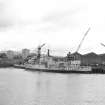Clydebank, Dalmuir, William Beardmore And Company, Shipyard
Aircraft Factory (First World War), Shipyard (20th Century)
Site Name Clydebank, Dalmuir, William Beardmore And Company, Shipyard
Classification Aircraft Factory (First World War), Shipyard (20th Century)
Alternative Name(s) River Clyde; Arnott, Young's Shipbreaking Yard; Royal Ordnance Factory
Canmore ID 90341
Site Number NS47SE 75
NGR NS 483 707
NGR Description Centred NS 483 707
Datum OSGB36 - NGR
Permalink http://canmore.org.uk/site/90341
- Council West Dunbartonshire
- Parish Old Kilpatrick (Clydebank)
- Former Region Strathclyde
- Former District Clydebank
- Former County Dunbartonshire
Fife (2007), in his survey of military flying in Scotland in the First World War lists the works of William Beardmore & Co (a shipyard) as also being a manufactury of land and sea-planes, and he published an photograph of the Dalmuir seaplane sheds. He reports that seaplanes were merely lowered in to the Clyde and flown off, while land planes were taken by road to the nearby Dalmuir aerodrome (see NS47SE 276).
The shipyard was split up and the E side became an Asbestos Cement Works. The dividing line resulted in the removal of W shed, which is pictured by Fife (2007) as gable end to the river, thus in effect splitting the aircraft factory into two seperate building, as depicted on the 4th edition OS 25-inch map.
Information from HS/RCAHMS World War One Audit Project (GJB) 2 October 2013.
NS47SE 75 centred 483 707
For (integral) hammerhead crane, see NS47SE 232.
(Location cited as NS 483 707). Shipyard, Dalmuir, built 1905 for William Berdsmore and Co. Some single-storey brick workshops and the fitting-out basin, now used for shipbreaking, are the principal remains of this once great yard.
J R Hume 1976
The works covered an area of some 90 acres when constructed, the river frontage measuring nearly a mile in length. The design and erection of the berth (with its jib travelling cranes) for battleship construction, the boiler and engine shops was carried out by Sir William Arrol and Co. Ltd.
William Arrol & Co 1909.
Project (March 2013 - September 2013)
A project to characterise the quantity and quality of the Scottish resource of known surviving remains of the First World War. Carried out in partnership between Historic Scotland and RCAHMS.








